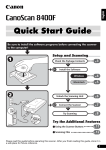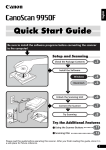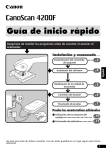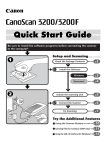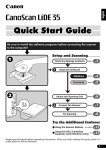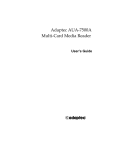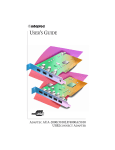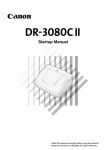Download Canon 500F - CanoScan LiDE Specifications
Transcript
English Quick Start Guide Be sure to install the software programs before connecting the scanner to the computer! Setup and Scanning p. 3 Windows p. 4 Macintosh p. 5 Unlocking the Scanning Unit p. 6 Positioning the Scanner p. 6 Connecting the Scanner p. 8 Positioning Items p. 9 Checking the Package Contents Installing the Software Try Scanning p. 12 Using the Scanner Buttons p. 15 Scanning Film p. 16 Please read this guide before operating this scanner. After you finish reading this guide, store it in a safe place for future reference. 1 Guide to the Manuals Guide to the Manuals Open the Package Quick Start Guide (this guide) This guide describes a series of basic processes from opening the package to using the scanner. READ THIS GUIDE FIRST! Scanning Guide (HTML format manual) HTML Refer to this guide when you have finished setting up the scanner according to the procedures in the Quick Start Guide. It describes how to utilize the scanner with the bundled software, and how to solve problems when they occur. You can install this manual onto the hard disk together with the software programs. When you install it, the Scanning Guide icon will appear on the desktop. Double-click the icon to view it with a browser program, such as Internet Explorer. You can also view it by clicking the [?] button in ScanGear CS and CanoScan Toolbox. Users’ Guides for Application Programs (PDF format manuals) PDF • ArcSoft PhotoStudio • ScanSoft OmniPage SE Select the “Reference Manual” menu on the CanoScan Setup Utility CD-ROM. To read these manuals, Adobe Acrobat Reader should be installed on your computer. The socket-outlet shall be installed near the equipment and shall be easily accessible. Use of a shielded cable with the ferrite core(s) provided with the scanner is necessary to comply with the technical requirements of the EMC Directive. Warning When you use this product, you should pay attention to the following legal issues: • Scanning of certain documents, such as bank notes (bank bills), government bonds and public certificates, may be prohibited by law and may result in criminal and/or civil liability. • You may be required under law to obtain authorization from a person possessing copyrights or other legal rights to the item being scanned. If you are uncertain of the legality of scanning any particular item, you should consult your legal adviser in advance. • • • • • • CanoScan and ScanGear are trademarks of Canon Inc. Adobe, Acrobat and Photoshop are trademarks of Adobe Systems Incorporated. Microsoft and Windows are registered trademarks of Microsoft Corporation in the U.S. and other countries. Macintosh, Power Macintosh and Mac OS are trademarks of Apple Computer, Inc., registered in the U.S. and other countries. ScanSoft and OmniPage are trademarks of ScanSoft, Inc. Other names and products not mentioned above may be trademarks or registered trademarks of their respective companies. In this guide, Windows XP screen shots are used to illustrate explanations common to all operating systems. 2 Checking the Package Contents English Checking the Package Contents Scanner and Accessories CanoScan LiDE 500F USB Interface Cable Film Guide (for 35 mm film strip) Film Adapter Unit Documents and Software Programs • Quick Start Guide (this guide) • Additional Documents • CanoScan Setup Utility CD-ROM ScanGear CS - Scanner Driver It allows you to scan and load images from the scanner. CanoScan Toolbox - Scanning Utility Program It allows you to scan, save, or print images easily as well as create e-mail attachments or PDF files. ArcSoft PhotoStudio - Image Editing Program It allows you to load images from the scanner, edit and retouch them, and apply special effects and enhancements. ScanSoft OmniPage SE - OCR (Optical Character Recognition) Program It converts characters scanned from a book, magazine or newspaper into text data for editing or digital transmission. *This does not support Windows 98 first Edition. Adobe Acrobat Reader - PDF File Reader Program Electronic manuals for the above software programs (HTML and PDF manuals) Approximately 210 MB/165 MB (for Windows/Macintosh) of hard disk space on your computer is required to install all the programs. Additional free hard disk space is required to operate the programs. 3 Installing the Software (Windows) Installing the Software Windows (Windows) • If you are running Windows XP or Windows 2000 Professional with multiple user accounts, you should log on with an administrator user name when installing or uninstalling software programs. 1 Turn the computer on. If the "Found New Hardware Wizard" or "Add New Hardware Wizard" appears, click [Cancel]. 2 Place the CanoScan Setup Utility CD-ROM in the drive. After you select your language, the CanoScan Setup Utility main menu will display. 3 Click [Install]. Read the "Notes on Software Installation" and click [Next]. The [Install] window will display. 4 Click [Install]. Read the Software User License Agreement. Click [Yes] if you accept the terms. You will install five software programs and the Scanning Guide (HTML format manual). 5 Follow the on-screen message prompts and click buttons such as [Install], [Next] or [Yes] to continue the installation. • In a few cases, your operating system may require a restart. Follow the on-screen messages to restart and resume installation. 6 When the "Installation Results" displays, click [OK]. The registration dialog will display. Follow the on-screen message prompts to register this product. 7 When "Installation completed successfully" displays, click [Restart]. The computer will restart. 8 After Windows restarts, remove the CD-ROM from the drive and store it in a safe place. Continue to page 6. 4 Installing the Software (Macintosh) Macintosh (Macintosh) English Installing the Software 1 Turn the computer on. Log in as the first created administrator to install the software. You cannot install the software when logged in using added administrator accounts. 2 Place the CanoScan Setup Utility CD-ROM in the drive. Double-click the CD-ROM icon. 3 4 Double-click the [SetUp] icon. After you select your language, the CanoScan Setup Utility main menu will display. 5 Click [Install]. Read the "Notes on Software Installation" and click [Next]. The [Install] window will display. 6 Click [Install]. Read the Software User License Agreement. Click [Yes] if you accept the terms. You will install five software programs and the Scanning Guide (HTML format manual). 7 Follow the on-screen message prompts and click buttons such as [Install], [Next] or [Yes] to continue the installation. If a verification dialog appears, type the administrator's name and password. 8 When the "Installation Results" displays, click [OK]. The registration dialog will display. Follow the on-screen message prompts to register this product. 9 When "Installation completed successfully" displays, click [Restart]. The computer will restart. 10 After restarting, remove the CD-ROM from the drive and store it in a safe place. 5 Unlocking the Scanning Unit/Positioning the Scanner Unlocking the Scanning Unit 1 Peel the seals off the scanner. 2 Slide the lock switch toward the unlock mark ( ). Lock Switch Unlock Mark • When carrying or transporting the scanner, always lock the scanning unit by sliding the lock switch toward the lock mark ( ). Positioning the Scanner This scanner may be used in a variety of positions. (a) Landscape Position (a) This position is to set the scanner so that the document cover opens from the front to the back. It is possible to scan thick or large items, and also films can be scanned. Portrait Position (b) (b) This position is to set the scanner so that the document cover opens from the left to the right. It is possible to scan thick or large items, and also films can be scanned. Upright Position (on the Stand) (c) This is the most space-saving position to set the scanner. It is possible to scan thin items, but films cannot be scanned. 6 (c) Positioning the Scanner English Setting the Stand • The scanner weighs approximately 2.0 kg. Be careful not to drop. • Before setting the stand, make sure that there isn't a space between the document cover and the surface of the document glass (p. 11, Step 3). 1 Turn the scanner upside down. 2 Lift the stand on the scanner back in the direction of arrow c and then arrow d. 3 Place the stand's end around the front side of the scanner (arrow e). 4 Push to the direction of arrow f until the S marks on the scanner and the stand align. 5 Slowly turn the scanner over and set it upright on the stand in position. 7 Connecting the Scanner Connecting the Scanner 1 Connect the scanner to the computer with the supplied USB interface cable. USB Connector Wide Flat Connector Small Square Connector USB Interface Cable • Only use the USB interface cable provided with the scanner. Use of other cables may lead to a malfunction. • When the scanner is connected to the USB 1.1 port on Windows XP and "HI-SPEED USB Device Plugged into non-HI-SPEED USB Hub" message appears, ignore the message. The scanner operates in this condition without problems. • The scanner does not have a power switch. The power is activated as soon as the computer is turned on. There are cable holders on the side of the scanner to hold the USB cable. Use the holders to organize the cable. Hold the cable with the holders before setting up the stand in the upright position. Cable Holders 8 Positioning Items English Positioning Items Items can be scanned in three different ways: scanning standard items, scanning oversize items, and scanning on the stand. The following procedures explain how to position items for each method. • When opening the document cover, support it with your hand until it stops. • Do not place items that weigh 2.0 kg or more on the scanner. In addition, do not press heavily on the document cover or the item while it is on the scanner. Scanning Standard Items Follow the procedure below to scan photos and other items smaller than the document glass. 1 Open the document cover. Alignment Mark The document cover will open as far as the position shown to the right and stop. 2 Place an item on the document glass and Top Bottom adjust its top corner with the alignment mark. 3 Gently close the document cover. • You can position items, such as magazines and books, up to approximately 24 mm thick on the scanner. 9 Positioning Items Scanning Oversize Items Follow the procedure below to scan magazines, books and other items larger than the document glass. 1 As shown in the right figure, hold the antislip grip on the center of the document cover and open it partway (arrow c). Antislip Grip 2 When the document cover is open to approximately 60°, lightly pull it straight up a short distance (arrow d). 3 Keep light upward tension on it as you slowly swing the cover open the rest of the way (arrow e). • Do not force it if it does not open easily as shown on the right. Repeat the procedure from Step 2. 4 Position the item on the document glass. Top Alignment Mark Bottom • Cover the scanner with a black cloth if the external light enters around the scanned item. 10 Positioning Items English Scanning on the Stand Follow the procedure below to scan items positioning the scanner upright on the stand. 1 Gently open the document cover until it stops. Approximately 40° • Do not force the document cover open. You might damage or collapse the stand. 2 Slide down the item along the document cover as shown in the right figure. • Scan only thin items in this upright position such as a single sheet or a double-folded sheet. Top Thin Item Alignment Mark Bottom Document Cover 3 Close the document cover. The document cover contains a magnet to help it stick to the scanner body. • If there is space between the joint of the document cover and the document glass as shown in the left figure, put the stand back, open and close the cover once again to reposition the joint as shown in the right figure. Use the scanner in the landscape or portrait position to perform the following. • To scan thick items, such as magazines or books (p. 9). • To scan items larger than the document glass (p. 10). • To scan films (p. 16). 11 Try Scanning Try Scanning This will explain the basic scanning procedures using the image editing program, ArcSoft PhotoStudio, and the scanner driver, ScanGear CS. To scan without using an application program such as ArcSoft PhotoStudio, refer to "Scanning with ScanGear CS (ScanGear Starter)" in the Scanning Guide (HTML format manual). Alignment Mark 1 Place a photo or a picture on the document glass by aligning its top edge with the alignment mark, and close the document cover. Top Bottom Windows 2 Select [Start], [Programs] or [All Programs], [ArcSoft PhotoStudio 5.5] and [PhotoStudio 5.5]. Macintosh 2 Double-click the [Applications] folder followed by the [PhotoStudio] folder and the [PhotoStudio] icon. PhotoStudio will start. PhotoStudio will start. 3 Click the [File] menu and choose [Select Source]. Select your scanner model name and click the [Select] button for Windows or the [OK] button for Macintosh. • After you set this setting the first time, you do not need to set it from the second time onward with the same scanner. • You will need to do it if you select a different scanner or a digital camera. 12 Try Scanning and select [Acquire]. or click the [File] menu English 4 Click the Acquire icon ScanGear CS will start. • In the Simple Mode in ScanGear CS, you can scan in three easy steps: (Step 5) Select Source, (Step 6) Preview and (Step 8) Scan. 5 Select a Select Source option. Select [Photo (Color)]. 6 Click [Preview]. After calibration, the preview scan will start and gradually display the image. • Do not touch the scanner while it is operating. 7 If necessary, perform the following step. Select a Destination option. Select an option according to how the scanned image will be used: [Print (300 dpi)], [Image Display (150 dpi)] or [OCR (300 dpi)]. Determining the Output Size • With Print (300 dpi), select the size of the output paper. • With Image Display (150 dpi), select a size appropriate for your computer display. • When OCR (300 dpi) is selected, the Output Size is fixed to the Flexible option. • The Flexible option scans the item at a scale of 100%. [Print (300 dpi)] [Image Display (150 dpi)] 13 Try Scanning Adjusting the Scan Area (Cropping Frame) If you want to trim the image further, drag the mouse diagonally to select the area. Correcting Images To correct the scanned image, click the appropriate check box to place a check mark in it. 8 Click [Scan]. The final scan will start. • Do not touch the scanner while it is operating. 9 Click the close box (Windows) or (Macintosh) in the ScanGear CS window to close it. The scanned image will appear in the PhotoStudio window. 10 Save the scanned image. Click the [File] menu and select [Save As]. Select the folder where you wish to store the image file, enter a file name, select a file type (JPEG format is recommended) and click [Save]. 11 Click the close box (Windows) or (Macintosh) in the PhotoStudio window to close it. • If the scanner does not perform as described above, read the "Troubleshooting" section of the Scanning Guide (HTML format manual). • For details about the bundled software programs, read the Scanning Guide or the user guides (PDF format manuals) for each software program on the CanoScan Setup Utility CD-ROM. 14 Using the Scanner Buttons Pressing the four convenient buttons on the scanner scans and performs the related tasks easily. Before pressing these buttons, make sure that ScanGear CS, CanoScan Toolbox, ArcSoft PhotoStudio and Adobe Acrobat Reader should be installed from the CanoScan Setup Utility CD-ROM. COPY Button Prints (copies) the scanned image with a printer. To use this button, the printer driver should be installed and the printer should be on-line in advance. PDF Button Saves the scanned image as a PDF file. Multiple items can be scanned continuously. The scanned image will be saved as a PDF document and appear in Adobe Acrobat Reader. A PDF (Portable Document Format) document uses a file format that allows it to be displayed and printed with an application program, such as Adobe Acrobat Reader/Adobe Reader. SCAN Button Forwards the scanned image to the image editing program, ArcSoft PhotoStudio. E-MAIL Button Attaches the scanned image to a new e-mail message. To use this button, one of the following e-mail programs should be installed to the computer and also it should be enabled in advance. The first time this button is pressed, the [E-mail software selection] dialog will appear where the e-mail programs for the use of this button can be selected. For Windows: Microsoft Outlook Express, Microsoft Outlook, Eudora or Netscape Messenger. (Some mail programs require the MAPI function to be set to On.) For Macintosh: Mail, Eudora or MS Entourage. • Please refer to the Scanning Guide (HTML format manual) for the details of the scanner buttons. 15 English Using the Scanner Buttons Scanning Film Scanning Film This scanner can scan 35 mm film strip one frame at a time. Preparing to Scan Film Use the following procedures to place the film adapter unit and the film guide on the document glass to scan film. • You cannot scan film with the scanner in the upright position. • Clean the document glass before placing the film guide on it, otherwise dirt and dust can affect image quality or damage the film. • Use a blower brush to remove any dust from the film, which will affect the image quality, and take care to hold the film by its edges to avoid transferring dirt or fingerprints to it. 1 Attach the cable for the film adapter unit to the FAU connector on the scanner's side panel. 2 Open the document cover and place the film guide on the document glass of the scanner. Fit the two tabs on the film guide into the document glass slots. • When opening the document cover, support it with your hand until it stops. Calibration Calibration is required when film is first scanned. Calibration is the process ScanGear CS uses to adjust to the correct color balance. If there is film in the film guide, remove it before setting the film adapter unit on it. 1 Remove the cap from the film adapter unit and gently set the film adapter unit over the first frame in the film guide. Align the tab on the film adapter unit with the film guide. • Be careful not to lose the cap or to allow dirt into it. 16 Scanning Film English 2 Gently close the document cover. • Do not press down on, or rest your hands on the document cover. 3 Start ArcSoft PhotoStudio. Refer to step 2 on page 12. 4 Start ScanGear CS. Refer to step 4 on page 13. ScanGear CS will start. 5 Select a Select Source option. You can select from the following options for films. Negative Film (Color) / Positive Film (Color) 6 Click [Preview]. The “Executes calibration.” message will display. 7 Click the [OK] button. The calibration process will start and take approximately 1 to 2 minutes. The calibration process is finished when the message disappears. • Do not touch the scanner while it is operating. 8 To go on to scan films, follow steps 1-3 on the next page and click the [OK] button. The preview scan will start. Read from Step 8 onward in procedures for “Scanning Film” (p. 19). To stop scanning film, click [Cancel]. 17 Scanning Film Scanning Film 1 Place the film in the film guide. White Line Place the film face up in the film guide (images and words should read correctly from above) with the spaces between frames aligned with the white lines on the guide. 2 Remove the cap from the film adapter unit and gently set the unit over the frame you wish to scan. Align the tab on the film adapter unit with the film guide. • Do not move the film adapter unit once it has been placed on the fIlm guide. Sliding it may scratch the film. 3 Gently close the document cover. • The document cover does not touch the document glass completely. Be careful not to force the document cover down. 4 Start ArcSoft PhotoStudio. Refer to step 2 on page 12. 5 Start ScanGear CS. Refer to step 4 on page 13. 6 Select a Select Source option. You can select from the following options for films. Negative Film (Color) / Positive Film (Color) • Use ScanGear CS’s Advanced Mode to scan monochrome films (See the Scanning Guide.). 18 Scanning Film 7 Click [Preview]. English ScanGear CS will display the preview image. • Do not touch the scanner while it is operating. 8 If necessary, perform the following step. Select a Destination option. Select an option according to how the scanned image will be used: [Print (300 dpi)] or [Image Display (150 dpi)]. Determining the Output Size • With Print (300 dpi), select the size of the output paper. • With Image Display (150 dpi), select a size appropriate for your computer display. • The Flexible option scans the item and enlarges 35 mm film to the photo size (4” x 6”). [Print (300 dpi)] [Image Display (150 dpi)] Adjusting the Scan Area (Cropping Frame) If you want to trim the image further, drag the mouse diagonally to select the area. Correcting Images To correct the scanned image, click the appropriate check box to place a check mark in it. 9 Click [Scan]. The final scan will start. • Do not touch the scanner while it is operating. 19 Scanning Film 10Click the close box (Windows) or (Macintosh) in the ScanGear CS window to close it. The scanned image will appear in the PhotoStudio window. 11 Save the scanned image. Click the [File] menu and select [Save As]. Select the folder where you wish to store the image file, enter a file name, select a file type (JPEG format is recommended) and click [Save]. 12Click the close box close it. (Windows) or (Macintosh) in the PhotoStudio window to • If the scanner does not perform as described above, read the "Troubleshooting" section of the Scanning Guide (HTML format manual). • For details about the bundled software programs, read the Scanning Guide or the user guides (PDF format manuals) for each software program on the CanoScan Setup Utility CD-ROM. Post Film Scanning Procedures 1 Open the document cover, remove the film adapter unit. 2 Put the cap on the film adapter unit. 3 Remove the film and the film guide from the document glass. • Always put the cap back on the film adapter unit when it is not in use. • Film may be damaged if it is left on the document glass for extended periods of time. 20 Specifications Scanner Type Flatbed Scanning Element CIS (Color Contact Image Sensor) Light Source 3-color (RGB) LED Optical Resolution 2400 x 4800 dpi Selectable Resolution Scanning Bit Depth Scanning Speed *2 (Photo or Document) Scanning Speed Preview Speed English Specifications *2 25 - 19200 dpi (ScanGear CS) Color Grayscale Color Grayscale, B&W 16 bit input/16 bit or 8 bit output *1 10.38 msec./line (1200 dpi), 20.7 msec./line (2400 dpi) 4.98 msec./line (1200 dpi), 6.9 msec./line (2400 dpi) 5.16 - 82.56 msec/line (Film) Approximately 9 sec. *3 Interface USB 2.0 Hi-Speed/USB (USB 1.1 equivalent) Maximum Document Size A4/Letter: 216 x 297 mm Film Type/Number of Frames Scanner Buttons 35 mm strip (negative/positive) *4 / 1 frame 4 buttons: COPY, SCAN, PDF, E-MAIL Temperature Operating Range 16 bit input/16 bit or 8 bit output for each color (RGB) Humidity 5°C to 35°C (41°F to 95°F) 10% to 90% RH, 20% to 80% RH when scanning film (without condensation formation) Power Requirements Supplied via USB port (No external adapter required) Power Consumption In operation: 2.5 watts maximum, Stand-by: 1.4 watts Maximum Exterior Dimensions Weight 280 x 396.5 x 34.9 mm Approximately 2.0 kg *1 16 bit output supported for film scanning only. The fastest speed in USB 2.0 Hi-Speed mode on Windows PC. Transfer time to computer is not included. *3 Calibration processing time is not included. *4 35 mm slides not supported. • Note that Macintosh computers with USB 2.0 Hi-Speed interface expansion cards are not supported. • Specifications are subject to change without notice. *2 Optional Accessory Kit • You can purchase the following Accessory. Accessory Kit CSAK-LiDE 500F : film guide, cap for film adapter unit Upgrading to USB 2.0 (Windows Only) To upgrade a computer to the USB 2.0 standard, please use one the following USB expansion cards/hubs that have been verified by Canon for compatibility. Expansion Cards Hubs • Adaptec USB2connect 5100 • PCI bus Adaptec XHUB4 • Adaptec USB2connect 3100LP • PCI bus Adaptec XHUB4PLUS • Adaptec USB2connect 2000LP • PCI bus Adaptec XHUB7PLUS • Adaptec DuoConnect: PCI bus For installation procedures, please read the instructions that accompany the USB expansion card/hub. • After upgrading to Windows XP, reinstall ScanGear CS and CanoScan Toolbox according to the steps on page 4. 21 System Information System Information This form should be used to record the operating environment for the purchased scanner. If any problems occur with the scanner, you will need this information when you contact our Customer Support Help Desk. Be sure to record the information and store it in a safe location. • This information is also required to request a repair under warranty. Make sure you record the information and store it in a safe location. • Guaranteed servicing for this equipment will expire five years after production ceases. Date of Purchase: Dealer Name/Dealer Tel: Dealer Address: Scanner Model: CanoScan LiDE 500F Serial Number (on the back of the equipment): • About the Computer Used Manufacturer: Model: CPU: Clock Speed: Memory Capacity (RAM): MB Hard Disk Capacity: MB OS: Windows XP Macintosh OS X v10.2 Me Space Available: 2000 OS X v10.3 Monitor Size: Printer: Manufacturer: Type of Printer: Printer Resolutions: Installed Compression Program: On-Board Expansion Cards: Attached Peripherals: Connected Network System: 22 MB 98 Monitor Type: Installed Virus Protection Program: MHz inches






















